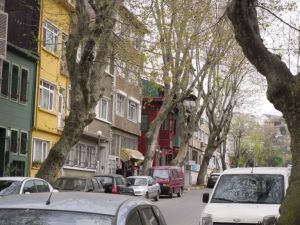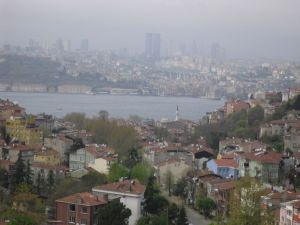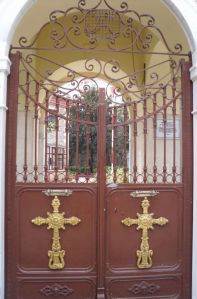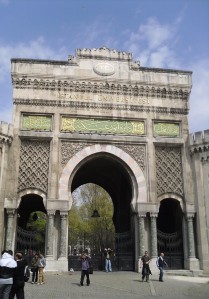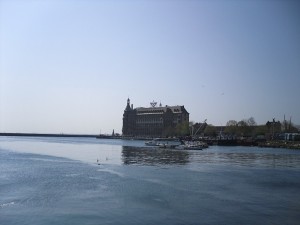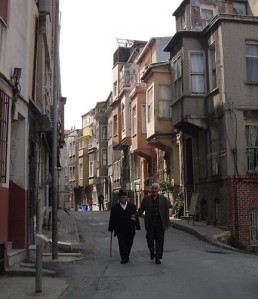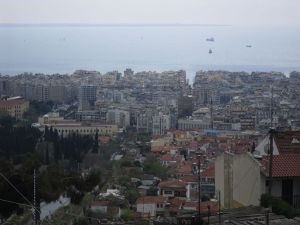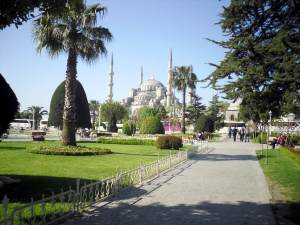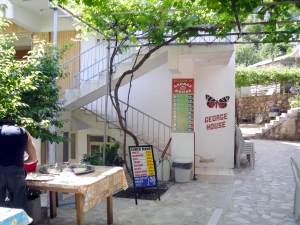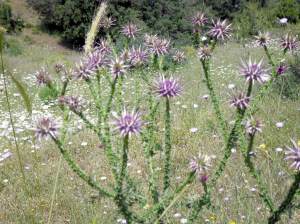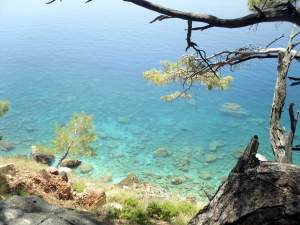Monday 12 April
Woke up cold despite the extra blanket I’d put onto the bed and hungry. Again i would need to seek out breakfast for myself; unlike in Turkey it doesn’t seem to be routinely provided in Greek hotels. I could hear the sounds of city life from outside the window although when I checked my iPhone it wasn’t yet eight. Downstairs the relatively friendly lady who’d checked me in the night before was gone and had been replaced by a relatively unfriendly man. I think this is the man I’d spoken to on the phone from Istanbul; he has the knack of sounding offended by anything you ask of him.
“Do you speak English?”
[Offended tone] “Yes, a bit.”
“Is it possible to get a map of Xanthi?”
[Offended tone] “Yes, here.”
And so on.
A short walk from the hotel i found a nice cafe: chic yet comfortable and somehow very ‘continental’. They sold beautiful fruit tarts and… filter coffee! I was also surprised to discover the assistant spoke some English. Mind you, I notice the Greeks use English quite a bit in advertising: the babywear shop across the road has a sign on the door saying “HOME” for instance – although I suppose it could be a Greek word.
Looking out of the window as i breakfasted i noticed the many Muslims in the town. They’re mostly Turkish-speaking and identify as ethnic Turks, it seems, although some Muslims in this area speak Bulgarian (and are known as Pomaks). I say ‘it seems’ because the Muslims of Xanthi rarely speak any minority language loud enough for it to be heard; it’s only when you’re standing close to people that you hear snatches of conversations in Turkish. The women dress conservatively in headscarves and long coats, which are almost all black. One younger woman had opted for a slightly different style: super-elaborate headscarf plus the slinkiest skirt I’ve seen since I arrived in Greece. It just about reached her knees. Ah well, at least it was black. The men, on the other hand, dress in ordinary western fashion and are indistinguishable from the Greeks – at least to my untrained eye. Greek women, by the way, dress like women in any other part of Europe; the days of dark dresses for mature ladies and conservative hemlines all round are long since gone if the towns i visited are anything to go by.
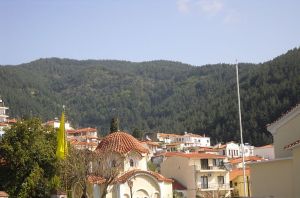
After breakfast i had a good wander round the Old Town, which is wonderfully pretty. I was particularly taken with the doors of the houses: each seemed to be unique. It’s bizarre that I only saw two other tourists. None of the buildings are actually that old though – the ones I saw all dated from the mid-19th Century or a few decades later; yet sadly many of them are in a poor state of repair. Given their touristic value this struck me as odd. Despite an abundance of dark red plaques affixed to the walls, providing information in Greek and English, none of the buildings appeared to be open to the public either.
An old Muslim lady stopped me as i was sight-seeing (aka ‘getting lost’) and began asking me urgent questions about something. Of course I had no idea what that something was – although, bizarrely, the one word i could identify was ‘Papas’, which i believe is Greek for ‘Pope’! Eventually I got her to understand that I was foreign. She laughed and walked off.

Around lunchtime i found that much longed for oasis… a bookshop selling books in English (albeit only a few) and with a helpful assistant to boot. I bought a book called Tormented by History* in which a pair of Turkish and a Greek historians compare the development of their respective nationalisms and a novel by a Greek writer called Vangelis Hatziyanndis**. It’s about a beekeeper’s son (of all things!) and won a Greek literary prize for best first novel in 2001. This turned out to be a great read, although its treatment of paedophilia was problematic to say the least.
In addition, I bought a map of Thrace. It covers both the Greek and Turkish portions. The Turkish place names are given according to their normal Turkish spelling but for many of them a Greek language name is also shown or/and a transliteration of the Greek pronunciation of the Turkish name into the Latin script – for example Çerkezköy is rendered ‘Tserkezkioe’. Who is this for? If it’s to help Greeks pronounce the Turkish name then why isn’t it written in the Greek alphabet?
The bookshop had a cafe upstairs, but it was deserted. The helpful shop assistant had followed me up however so i felt obliged to order some tea. It was strange sitting there all by myself but not unpleasant. What was unpleasant was the sofa on which i was sat; from a distance it looked like leather but it was actually made from plastic – white plastic. Plastic is like concrete: it quickly starts to look dirty as it wears; and these sofas are no exception. Alas, modernity!


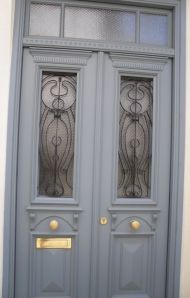
In the afternoon i did some shopping (as usual I had been overoptimistic about laundry facilities and was running out of clothes) and some more sight-seeing. The friendly lady who served me in the clothes shop had spent part of her childhood in Australia and was now regretting her decision to return to Greece, although she told me she preferred Xanthi to Athens where she’d been born. She advised me to go to the top of the hill above the Old Town if possible for a panoramic view of the town, which i did (it was a nice view and i saw a tortoise). I also fed some hungry cats; the moggies of Istanbul live lives of plenty compared to the scrawny creatures i encountered in Greece.

Back in the town, this time the newer section, i encountered the spectacle of two “American Indian musicians”, sporting the kind of costumes (feathered headdresses, etc) that you normally only see in movies and old sepia photographs. Amerindian these men may well have been (though not necessarily from the US), but musicians they most definitely were not. The music was ‘pre-recorded; occasionally they would inject a note from a wooden flute or bang a drum but it was almost at random. Behind them were hung two huge posters. One showed Jesus ascending to Heaven, the other two enormous bunny rabbits (each about three times as big as Jesus).
Eventually, tired out by my exertions and curious to know if i had any emails i took myself off to an internet cafe i’d seen opposite the bookstore i’d visited earlier. This was in fact the first internet cafe i’ve ever visited in my life. It was half full, mostly of teenage boys playing World of Warcraft and the like (with intense concentration – there was no conversation), and strangely dark. I wrote the first two instalments of my Trip 2010 saga there and savoured the feeling of connectivity, this being my first chance to use the internet since arriving in Greece – free internet access doesn’t seem to be a part of Greek hotel culture any more than breakfast is. An incidental discovery: Greek keyboards are even harder to get used to than Turkish ones!
And that, apart from another trip to the nice cafe for cake and tea, concluded my day in Xanthi.
Tuesday 13 April
Woke at eight – so much for my plan to out of the hotel by then. After repacking my rucksack (for some reason this gets harder, not easier, as a trip progresses) I went down to pay the bill. The evening before I’d been assured I could pay by card but the antiquated PIN terminal wouldn’t work; how can one of these already be antiquated? Chip & Pin has only been around for a few years. Ended up settling by cash and then took a taxi to the train station, where I bought my ticket to Alexandroupoli and discovered I had a two hour wait for the train.
It occurred to me that it might be possible to buy the ticket for the night train from Alexandroupoli to Istanbul at this station too. No harm in asking anyway. After a conversation with two members of staff, one of whom spoke quite good English, it transpired this was indeed possible. Only problem: payment is only possible by cash. At first I despaired as I’d handed over most of my cash at the hotel but then – miracle! – I found an extra 40 euros in one of my pockets. I felt relieved to have the ticket. Given how few tickets were left when I went with B to buy the ticket from Istanbul to Thessaloniki one day before travelling, it seemed entirely possible that there would be no tickets left when I got to Alexandroupoli. I was also given a piece of information which was to dominate my stay in the town: i was to go to the “Old Station” for the night train, and not the new one which all the other trains go to. The lady repeated this information several times.

The train was like the one i’d travelled on from Thessaloniki but thankfully the journey was shorter. Indeed we only seemed to pass through one town of any size and this was Komotini, notable for the fact that it’s the only town in Greece where Turks form a majority of the population (although only just). I’ve read that Turkish communities in Greece tend if anything to be more conservative than those in Turkey; ironically, by remaining in Greece, they avoided the secularisation of the Turkish republic. As we drew into Komotini a lady in a seat not far from mine stood up and donned a long black coat and headscarf before disembarking. I wondered whether she’d taken the coat and headscarf off to avoid problems on the train or was putting them on to avoid problems in the town.
Soon i was in Alexandroupoli, which initially looked quite promising, not least because I could see the sea as the train drew in. I quickly realised my mistake however: this is one of those places which somehow lack a soul. It’s very short of decent cafes too, although I found one eventually called Elemento 41, situated, as these places often are, next to a bookshop (which alas had scarcely any English language books). After struggling for about a quarter of an hour to decipher the Greek characters on the menu i selected one of a handful of dishes on offer whose name was given in English: a Greco-Burger! I also drank lots of tea, as it turned out they had real Japanese sencha on offer (!) and not made from bags either – no, this was loose tea in a pot, served with complimentary biscuits and sweets. The complimentary biscuits and sweets were a feature of Greek cafes in general and one i really liked. You never knew what they’d give you but it was always good.
Apart from cafes just about everything in this town seems to shut at 3 pm at the latest so I’d missed the museums and ended up spending the afternoon wandering about at random. One of the things i noticed was the curious relationship the town has with the nearby Greco-Turkish border: the town is as Greek as Greek can be and there’s much less evidence of the Thracian Turkish minority; yet here for the first time i saw road signs pointing out how close Turkey is – just 44 km (27 miles) away. I never saw any soldiers but i did see photographic displays featuring images of the military in the windows of shops. It was quite odd.
The other thing i noticed was how beautiful the dogs were. There were lots down by the seafront. I couldn’t work out whether they were strays or just pets out for a wander (apart from the few who were wearing collars). Many of them appeared to have some Labrador or Golden Retriever ancestry. Thankfully, neither the Greeks nor the Turks have yet been afflicted by leash-mania and consequently their dogs are calm and self-contained, just as i remember dogs being in my childhood, and not neurotic or aggressive like so many dogs in Britain are these days.
For a while I sat on a wall near the sea reading my Greek novel (the only one it appears i’m going to be able to buy!), but the temperature started to drop and the seafront is not actually very pretty in Alexandroupoli: the water looks dirty and oddly dark. In the end I gave up and returned to my hotel.

Wednesday 14 April
Woke to the sound of drizzle. I made my way into town to look for something to eat, eventually (inevitably?) settling for coffee and and a piece of complimentary cake at Elemento 41. The search for breakfast was nothing in comparison to the quest for the Old Railway Station however. No-one seemed to be able to tell me where this was; when i did get directions they were invariably wrong. Even the stationmaster at the New Station couldn’t help me: he directed me to a grey building further along the track which turned out to be a row of shops! At one point I was stopped by a police car; they were obviously suspicious of the way i was wandering along the road, examining every yard and driveway for signs that a railway station that might be hidden away inside.
The policemen were actually very nice when they realised i was merely lost, but Alexandroupoli isn’t the friendliest place I’ve ever been to in my life and the endless grid pattern of the streets gives it a dreary feel which doesn’t help matters. I’ve also noticed that although there are even more English language signs here than in Xanthi, fewer people speak English (the Greek paradox?).

Giving up (temporarily) the search for the Old Station, i decided to check out the town’s museums before they closed. I’d read about two but could only find one in the end: the Ethnological Museum, which collects together household items typical of the traditional culture of the region – a culture which seems to have survived into the first half of the Twentieth Century, but is now completely gone as far as i could see. There were women’s costumes featuring leaf patterns, aprons and coin decorations, and lots of different kinds of headgear. The men’s costumes were less spectacular apart from the footwear: clogs/slippers with great ‘bobbles’ at the end. Some of the costumes were not in fact Thracian but Cappadocian or Pontic, reflecting the influx of refugees in 1923. Other exhibits included tools used for farming and a music book, featuring a kind of notation i’d never seen before. Not many people seem to come to the museum; the caretaker had to switch the lights on for me.

Later that day the hotel manager (a lovely man who spoke very good English) gave me directions which enabled me to (finally!) find the old railway station***. The sense of relief! I really was starting to wonder if i’d ever see the place. It was a grey building (which explains the stationmaster’s mistake) but much further along the main road than any of the buildings people had directed me to. I celebrated with a Nutella-laden crepe pancake (Is there anywhere in the world Nutella has yet to reach!? Is there anywhere which has resisted it?) and some ariani, Greek ayran.
Afterwards it was just a matter of killing time until midnight (i tried to sleep but it was hopeless). Then i got my stuff together and walked along the dark street to the station – an eerie experience yet i felt completely safe. I found it deserted apart from a stationmaster, tucked away in his office, and an arthritic old dog trying to sleep on the platform. The dog woke up when i arrived and i fed him some treats, wondering if i was to be the only person to board the train and worrying vaguely that it might not stop. After about twenty minutes one other passenger arrived. He was followed, quite a bit later, by a whole group of people who seemed to be policemen and railway officials. At around 1 am (late as usual!) the train pulled in and we were off. Back to Turkey!

* Tormented by History: Nationalism in Greece and Turkey; ISBN: 978-1-85065-899-3; Uzut Özkırımlı & Spyros A. Sofos; pub. Hurst & Co (London, 2008)
**Four Walls; ISBN: 978-0-7145-3122-9; Vangelis Hatziyannidis; pub. Marion Boyars (2006)
*** The easiest way to find the “Old Railway Station” is to proceed along Dimokratias Avenue (Leoforos Dimokratias/ΛΕΩΦΟΡΟΣ ΔΗΜΟΚΡΑΤΙΑΣ) eastwards from the centre of the town. You cross the railway line (it will henceforth be to your right although you quickly lose sight of it behind the shops which line the road) and continue on (remaining on the right side of the road) for about 300 metres till, just after a branch of Alpha Bank, you see a boat shop on the opposite side of the road. You should now see a sign (on your side of the road) for the railway station which is a grey building (see photo above) and is set back from the road down a short drive. These directions should get you there – at least as long as the Alpha Bank branch and boat shop stay open!

